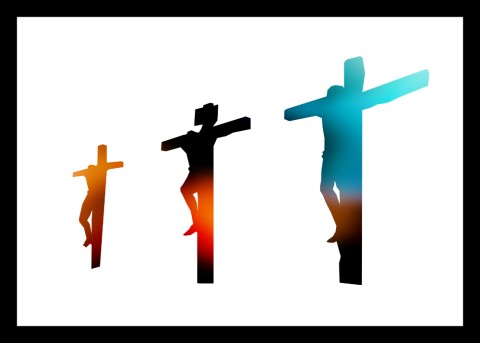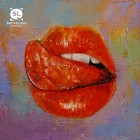I went to Mexico with my mother when I was twenty-four. We were going to spend two weeks on a tour of churches and shrines, and she was paying for everything. I liked the religious angle of the deal. Because of the delicate ecosystem of uppers and downers that comprised my bloodstream, I was afraid of everything, so I went to mass a lot and prayed the rosary. It calmed me, but I still spent a lot of time begging Jesus and the Virgin Mary to help me quit drugs or get drugs.
The trip was with a Catholic tour group, and the leader was a guy named Kenny who wore his shiny black hair in a bob, long in the front and tapered in the back. He wore denim shorts, broken-in t-shirts and a bandana around his neck. Hiking boots with thick socks. This was the nineties.
The afternoon we arrived in San Miguel, I decided I wanted to hang out with Kenny and see if he could help me find a pharmacy. One of the guys I waited tables with sold me Percocet in foil blister packs with the dosage printed on the back in Spanish. He took a bus to Guadalajara three times a year with his mom and some of the ladies she played cards with. They stocked up on Celebrex and tubes of Retin-A. He offered to sell me some of that, too; his skin was lovely. He made it seem like a person could walk into a pharmacy in Mexico and get a great big supply of whatever pharmaceutical ease and comfort they wanted, but half the trip was over and I hadn’t figured out how to accomplish the score I’d hoped for. Kenny changed the subject when I brought up drugs, and I played it off as a joke. I was disappointed, but we were having a good time.
San Miguel is named for St. Michael the Archangel. What a hunk. I still say his prayer when I’m afraid, envisioning myself hiding behind his big, macho wings and stone fortress of a face. There were murals and t-shirts and candles and snow globes and plastic beaded bracelets, all printed with a vivid portrait of St. Michael standing atop the devil, his right arm ready to plunge a long silver sword into the thing’s head.
Kenny took me to a chapel he knew about, hidden behind a larger church in the middle of town. The air within the concrete walls had a cool humidity and it was completely dark, except for the glow from a bank of candles near the altar rail and the sunlight filtering through the doors. Kenny and I knelt on the thin cushions at the altar rail and took out our rosaries. I said a decade of the Joyful Mysteries, and my mind began to wander. I opened my eyes.
A heavy plaster crucifix hung on the back wall of the chapel. The crucifixes and statues in Mexico are intense. Real hair affixed above grimacing faces and carved wood bodies draped in heavy velvet. Wounds that look like overripe fruit in the palms and feet and side of Jesus. Beyond Kenny, a teenage couple knelt in front of a cluster of candles. The girl’s hair covered her shoulders and one of the boy’s shoulders, too. He was crying, his face lifted in agony toward the altar. Her eyes were fixed on his face, and she held a red rose. She plucked the petals from the rose and used them to dry his tears, whispering to him while he whispered into his hands, clasped near his mouth.
At the chapel’s side door, Kenny stopped in front of a statue of an infant Jesus wearing a long blue gown. Two chalk-white porcelain teeth peeked over his lower lip. Kenny took my elbow. “He wants to tell you something.”
“Who?” I looked back, afraid that the teenagers had followed me with their grief.
Kenny tapped the statue’s little toes. “Him. Look into his eyes.”
I thought Kenny was joking, so I cocked an eyebrow and stepped into the street. He grabbed the back of my sundress and pulled me back in front of the baby. “Talk to him.”
I concentrated on the statue’s face, but my head was a hive of drug sounds, so I started making up the things baby Jesus wanted to tell me. He wanted to tell me that he was going to help me stop using. He wanted to tell me that it was okay to keep using.
When my mother and I got home from Mexico, she had the photographs from the trip developed. I was standing in front of the bathroom mirror picking at my face–something I was able to do for hours with the concentration of an air-traffic controller–when she knocked. I opened the door, and she was standing there with one of the glossy prints and a holy card.
“Look at this.” Kenny and I in front of the dusty bus. Kenny, holding a can of Dr. Pepper beside me, holding a lighted cigarette.
“Oh, Kenny. Kenny looks so good in this picture.”
She laid the holy card over the photograph. It was Jesus standing in two rays of light: one red, one bluish-white. He was reaching out with one hand, using the other to point at His Sacred Heart.
She pointed at the photo of Kenny and me, running her finger over a shaft of red light I hadn’t noticed before. It crossed Kenny’s face and my t-shirt. Then she traced a bright streak of light that entered the photo’s frame from the right and pierced my torso. “Blood and water from His side. You and Kenny are washed in the blood and water.”
I took the card and photo from her and closed the door. I cracked the window and smoked a cigarette to help me settle, aiming my exhales away from the photo, tracing the lines of light.

Notes from Guest Reader Allison Pinkerton
The central character in ‘San Miguel’ asks a statue of baby Jesus if she should quit drugs, and she imagines that he tells her both yes and no. That’s why I chose this story—the complicated narrator leans on Christian iconography to solve her problems, and the answers aren’t clear. Focusing on the questions raised by Christianity instead of the answers given by Christianity seems nuanced and appropriate for secular fiction.


 The SmokeLong Grand Micro Contest (The Mikey) is now an annual competition celebrating and compensating the best micro fiction and nonfiction online.
The SmokeLong Grand Micro Contest (The Mikey) is now an annual competition celebrating and compensating the best micro fiction and nonfiction online.